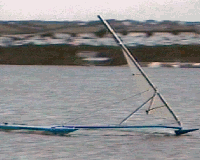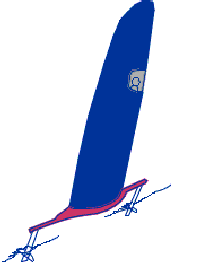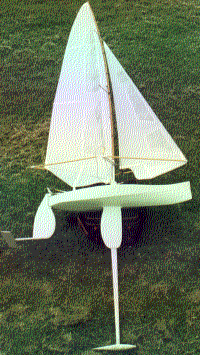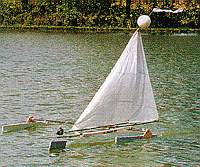Mr Smith's Amazing Sailboats
Model Craft by
Other Designers
Much of the developmental work Bernard Smith did was in the form of experimenting with
models, this being a very cost and time effective way of testing and refining ideas.
In this section, we take a general view of speed sailing models - not only looking
at those who have made models of Bernard's craft, but also viewing the work of other
designers. At the end of this section, some online and commercial
models are also
detailed.
This section is by no means complete - if you know of other designs worthy of inclusion
please email
aerohydro.
Tony Bigras
Based in British Columbia,
Canada, Tony built three aerohydrofoil-based models in the mid-70s. Additional photos and
details about Tony's models can be found here.

Jon Howes is a UK-based aeronautical engineer who in recent years has developed a type of speed sailing craft he's tentatively termed a "Monofoil". After tests with models, he's now constructing a full-sized craft. The image below shows Jon's first model, which was free running and inherently stable. Speeds of 15 knots or more were achieved with this 1-meter craft. More details about Jon's remarkable sailing machines can be found at http://www.monofoil.com

Jose has made a wingsail yacht that takes its inspiration - in part - from the work of Bernard Smith. The RC yacht has a 3-section, 2.8-meter long wingsail. Material used in its construction includes foam and carbon-fiber tubing. Jose is also currently the AMYA Open Class Secretary. More details on the yacht will be included when it comes to hand.
Krzysztof Mnich
Years ago,
Krzysztof
built a
small hydrofoil proa model
which he reports flew quite well. According to
Krzysztof the model was designed as an aero-hydrofoil Atlantic proa.
The sail was canted by 45 degrees, as
were the foils under the
ama. The rig and foils system gave
no heeling moment. The whole rig could turn around the vertical axis, so it
could orientate at an optimum angle of attack (in practice
it was used for self-steering the boat).
The model was 40cm long. Both hull and ama were
built of 0.4mm ply. When the wind was strong enough, the model flew on its 2
foils, lifted by the hydro+aerodynamical forces. What is surprising, it was
stable in this state, and really fast.
Email Krzysztof.
Click here to see a 3-view of the model
Giles Whittaker is a Scottish engineer who has recently invented the FSSC ("Foil Stabilised Sail Craft"). This is an ingenious concept in which a stabilizing hydrofoil is placed to windward of a hull and arranged in such a way as to provide a constant righting force, regardless of wave height etc. With such a clever idea, it's only appropriate to note that Giles says the "inspiration for this invention was that remarkable book, "The 40 Knot Sailboat" by Bernard Smith."
Giles is refining the concept using a series of models of increasing size and sophistication - he is now working with a 48" RC multihull. The image below (from Gile's website) is of the hydrofoil version of his 24" model. The stabilizing hydrofoil, fully immersed in the water, can just be seen at the left of the picture. The FSSC concept is fully explained at http://www.albury.net.au/~wwhittake/index.html.

Greg Ketterman
Famous for developing the Trifoiler hydrofoil,
Greg originally made a RC model in the early 80s to test the validity of his
ideas. Greg has kindly supplied a number of images of this seminal craft - these can
be found here.

Malcolm Barnsley
Malcolm previously helped to develop
the Snead Delta which is detailed in the Full-sized
Craft section. His current project is the SailRocket - an inclined rig proa.
Photos and a video of Malcolm's 1:5 scale proof-of-concept model can be found at the
SailRocket site. The
ultimate goal is to create a full-sized version and reclaim the speed sailing record for
Britain.

Fulgencio
García
A Spaniard, Fulgencio experimented in
1985 with this 1.2m x 0.7m hydrofoil proa model. The photo shows it during a towing
test, travelling at some 3m/s. There are three foils are all - one at each end of the
leeward hull and also one under the windward hull. The leeward hull foils are
T-shaped and are more-or-less end-on to the camera. The unique innovation of this
proa is that the steering is done by altering the dihedral angle of both leeward foils.

Alain is the man behind the L'Hydroptère, a very large and very expensive offshore racing hydrofoil. There is an excellent website (in French) which details the development of this magnificent flying monster, and also reveals a hydrofoil model from 1985.
Jean Margail
At his bilingual website, Jean details his WRC2 design - a 2m
RC catamaran equipped with two strangely-angled wingsails. Its hoped that, when
sailing, the wingsails will lift the entire craft up out of the water - eliminating
the need for hydrofoils.

Hanno Smits
Hailing from the
Netherlands, Hanno Smits has quite a remarkable web site at http://home.worldonline.nl/~hbsmits/.
Part of the site deals with hydrofoil sailing and reveals this
image. Remarkably similar in appearance to the Sailloon concept, but developed quite
independently from it. Hanno's concept uses the mass of the pilot within the wingsail to
provide balance. According to the site, some 15 years ago a RC model was built based on
this concept, though the model itself used a hull rather than hydrofoils. The model,
Hanno says, was made "to see if it
worked - it did."

aka the Wasp, aka Project Quicksilver. The work of designers Gary Hoyt, Richard Roake and Dave Penrick, the Killer Wasp really only existed as a virtual model, as reflected by this computer-generated wire-frame drawing. A small RC model was tested, but scaling problems were discovered. More details and further images of this foiler can be found here.

This exciting class is a phenomenon local to NSW, Australia and originated in the mid-80s. The class rules are few, but they're deliberately designed to encourage fast speeds, close quarter racing and innovative thinking. The yachts are 750mm long monohulls fitted with standard 2-channel RC. Multihulls are prohibited, but the Class secretary, Mal Smith, has been considering opening up the Class to hydrofoils. Visit Mal's site for more information.

Not content with working with wacky monohull models, industrious Mal Smith has also worked with proa models, investigating a concept where a sail and hydrofoils are aligned so as to cancel out heeling moments. (Shades of Bernard Smith... must be something in the surname.) Visit here for more details.

In New Holland, Pennsylvania, Gary Halls has been experimenting with a craft he calls the L-Trimaran. This is a triscaph with a sliding rear cross beam. The mast, buoyant front rudder and main framework are effectively one item and can slide along the beam, so arranging one of the rear floats to as far windward as possible. Speeds of 20mph have been reported for this 5' 6" long craft. For more details, look at the article in the August 2000 issue of "Radio Control Boat Modeler" (ISSN 1043-8009)

A model outrigger sailing canoe, from the Marshallese Islands in the Pacific. There has been a renaissance recently to build and sail these very fast free-sailing models. Tim Anderson has a page detailing the Riwuit and also has provided free online plans of the current champion model. It's 6ft long and went 5 miles in about 20 minutes. In other words it's very fast.

The world's first production sailing hydrofoil model. A project of the Microsail company in Florida, the F³ is a radio controlled trimaran fitted with foils and is a development of their Flyer³ displacement trimaran model. The foiler is 55 ¾ inches long by 62 inches wide and can be broken down into to a compact 12" x 12" x 60" box for easy transport. Yours for only $US1,950.00! Visit www.microsail.com/f3.html for more details.

As far as I'm aware, this is the only sailing hydrofoil model for which plans are available. The design of FJ MacClay, it's a 60cm long free-sailing model, made of balsa and ply. An article on it appears in the June 1974 issue of "Model Boats" (pp206-7). Based on Donald Nigg's Flying Fish hydrofoil, the Sail Foil is described as "a simple but unusual model" & "capable of fast and exciting performance".

Plans of the Sail Foil (plan
reference MM1185) can be purchased for £5.50 (for UK residents, add £2.50 for postage)
(for all overseas customers, postage is also £2.50, but this is for accelerated surface
post).
Plans Department
Nexus Special Interests Ltd
Nexus House, Boundary Way
HEMEL HEMPSTEAD
Herts, HP2 7ST
United Kingdom
And finally, no models, but here are some wild ideas for a flying sailboats and a boat the shape thats the shape of a triangle. Further details on can be found here.
